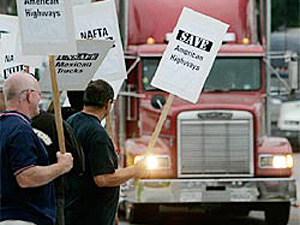 |
 |
 |
 News from Around the Americas | September 2007 News from Around the Americas | September 2007  
Mexican Trucks Get Green Light to Cross Over
 BYLINE BYLINE


| | Dozens of Teamsters-led truckers mixed with anti-illegal-immigration activists protested the pilot program near San Diego's Otay Mesa border crossing. (Eduardo Contreras/Union-Tribune) |
A controversial, long-delayed program to allow Mexican trucks to roam freely throughout the United States took effect last night after the U.S. Transportation Department granted the final approval.

Mexican trucks could begin rolling across the border today, though officials said it probably would take several days for the companies to map out their new routes.

The unprecedented border opening, which the administration said was required under the North American Free Trade Agreement, marks the first time that Mexican trucks will be allowed to travel beyond a 25-mile buffer zone to which they have been confined since 1982.

It also marks the first time that U.S. trucks will be allowed the same access in Mexico, said John Hill, administrator of the Federal Motor Carrier Safety Administration.

In a conference call with reporters last night, Hill said the one-year pilot program would eliminate the need for Mexican trucks at the border to transfer their cargo to U.S. trucks that then carry them elsewhere in the United States.

The program will allow up to 100 Mexican companies to send trucks across the border to deliver their loads anywhere in the country. So far, 38 Mexican trucking firms have gotten clearance, Hill said.

Mexican officials have committed to allow trucks from as many as 100 U.S. firms to go anywhere in Mexico by the end of this year, Hill said, and 14 are poised to receive permission.

“This means less traffic and less pollution at our borders, and more opportunities for U.S. trucking companies and shippers, all of which will lead to significant savings for countless consumers and businesses,” Hill said.

Opponents of the border opening – including dozens of lawmakers, the Teamsters union, trucking organizations and highway safety groups – had sought to block the program because they believe Mexican trucks pose a risk on U.S. highways and could be used to smuggle drugs or terrorists across the border.

Critics hope it will be stopped by ongoing litigation or by Congress.

At a Capitol Hill news conference earlier in the day, Rep. Peter DeFazio, D-Ore., blasted the administration for failing to address concerns about the accuracy of drug and alcohol tests of Mexican drivers; lax enforcement of Mexican traffic laws; and what he said was the unreliability of Mexican driver records.

“We do not find that the Mexican system is equivalent to the American system,” DeFazio said.

The news conference also included an emotional presentation by Sheryl McGurk, an Alexandria, Va., woman whose parents and nephew were killed in a crash with a Mexican truck driver in San Diego two years ago.

“My parents and nephew never had a chance,” said McGurk, whose parents, Robert and Marie Jennings of Carlsbad, and nephew, David Jennings II of Ohio, died in the Feb. 15, 2005, crash.

Although police did not find the Mexican driver to be at fault, McGurk said she blames the truck because it was stalled in the freeway after losing a drive shaft when it was hit by her parents' van.

“The truck and the driver basically disappeared across the border, and we had no recourse,” said McGurk's husband, Sean, describing the family's unsuccessful efforts to track down the driver for a statement.

At a protest yesterday near San Diego's Otay Mesa border crossing, dozens of truckers led by the Teamsters mixed with anti-illegal-immigration activists. Business was uninterrupted, said Lt. Hector Paredes of the California Highway Patrol, which inspects about 3,000 trucks a day at the crossing.

“We're already inspecting Mexican trucks and will continue to inspect them the same way,” Paredes said. “These trucks already haul product from Tijuana to San Diego. Now they will be able to go beyond San Diego.”

Hill said the Federal Motor Carrier Safety Administration has made painstaking efforts to ensure the program is safe, including conducting pre-authorization inspections of Mexican carriers, pledging to check every truck that crosses the border and making sure Mexican drivers comply with all U.S. laws.

Officials were able to start the program last night after receiving an assessment from the Department of Transportation's inspector general, which certified that it complies with congressional requirements.

The agency announced that the first two carriers granted operating authority were Transportes Olympic in Nuevo Leon, Mexico, and Stagecoach Cartage and Distribution of El Paso, Texas.

In response to an unsuccessful lawsuit filed last week to block the program, U.S. transportation officials said one of the initial companies to get authorization for the program would be Luciano Padilla Martínez in Tijuana.

Hill said the carrier wasn't cleared on the first day because it has yet to prove it has secured the required $750,000 insurance policy from a U.S. insurer.

The border had been scheduled to be opened to two-way truck traffic in 1995, but the opening was delayed by President Clinton, who had concerns about Mexican safety regulations.

A NAFTA arbitration panel ruled in 2001 that the moratorium violated the treaty. In February of this year, U.S. Transportation Secretary Mary Peters announced that the Bush administration would go forward with a one-year demonstration project as a prelude to full opening of the border.

When the pilot program is over, administration officials hope to open the border to any Mexican and U.S. carriers that qualify.

The Associated Press contributed to this report. | 
 | |
 |



